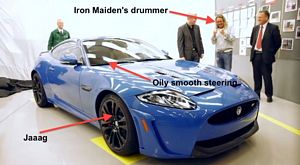|
By accessing/using The Crittenden Automotive Library/CarsAndRacingStuff.com, you signify your agreement with the Terms of Use on our Legal Information page. Our Privacy Policy is also available there. |

Analogue cars, and music, in a digital era
|
|---|
|
|
Analogue cars, and music, in a digital era
Matt Hubbard
Speedmonkey
August 27, 2013
I know more about rock music than I do about cars, but cars are more fun to write about. I spent my first ever two weeks wages (£4.50 a week as a paperboy, 6am start every single day) on a Muddy Waters album.
That was 1984 and Duran Duran and Wham! were riding high in the charts. I couldn't give a fig about such electronic pop. I was far more interested in noisy rock and blues - and still am. My choice in cars is similarly luddite. My 2004 Audi S4 is for sale due to lack of use whilst I drive everywhere in my 1986 Porsche 924S.
The Porsche has steering so natural and communicative it's as though your fingertips are touching the road itself. The Audi's couldn't be more different. It feels as though they've started with a remote steering system and tried to engineer feel in.
This is the case with many modern cars. You turn the wheel left and the car goes left - just as it does in a computer game. What's often missing is the connection between road and soul.
Music can do the same thing. When Noel Redding plays the chromatic scale on his bass towards the end of Hey Joe it connects directly with my soul and sends a shiver down my spine.
Hey Joe was recorded in 1966 by The Jimi Hendrix Experience. The instruments were a guitar, a bass and some drums. The sound desk that recorded the song was electric but not electronic. The music was recorded onto tape.
My Porsche 924S has electric components, but nothing in the way of electronica (aside from the stupid aftermarket alarm). The windows are electric but the switches that operate them are vast and basic, and the wiring rudimentary.
We now drive cars that are controlled by electronics, and listen to music composed, played and recorded largely on electronic equipment. As a result I believe we have lost something in the way of a connection between the product and the consumer.
Modern car's accelerator, brakes, gearbox and steering usually has a bunch of computers that monitor external conditions and driver inputs and deliver what they think to be the correct result. The driver might think he or she is driving the car but in reality the onboard supercomputers listen to what the driver has to say, and then do what they thinks best.
This is conducted on such an infinitesimal level that it is generally not noticed, unless the driver has a super-keen sense of driving reality. As I do - and probably you too if you are reading this.
Cars will never go back to the analogue devices some of us know and love. If you want analogue feel you must buy an old car.
Until 1980's The Game, Queen used to include the message, "No synths!" in the sleeve notes. After the introduction of synthesisers, which they came to embrace wholeheartedly, Queen's music lost a little of its soul. It takes slightly less effort to create new and unusual sounds without resorting to computers.
The same goes for The Rolling Stones who produced some of the best music anyone has ever recorded from 1968 to 1974. In 1976 they released Black and Blue, which attempted to emulate disco, and featured a synth for the first time - and it was dismal. They haven't recorded a decent album since.
Even Iron Maiden weren't immune to the curse of electronica. In 1986 they recorded Somewhere in Time which used "guitar synthesisers." Their standard of music then dropped off as synths infested the riffs.
But, in 2000 Maiden returned to form with the majestic Brave New World, which featured three full time guitar players - and a small smattering of synth - and haven't looked back since.
I can't think of a car company who have suffered such a drop in form and then such a revival, other than Jaguar. After a majestic 60s and 70s they failed to release any decent new models through the 80s. Then, under Ford's stewardship they released the lamentable S-Type and X-Type, and the half decent XK.
It wasn't until 2008's XF that Jaguar shot back into form. Thereafter followed the new XK, XJ and F-Type. And whilst modern Jaguars might be riddled with electronics their steering is still oily smooth - just like it was in the classic Jags of yore.
Mercedes-Benz demonstrates superbly the move from analogue to digital via their E-Class cars. The W124 was well-engineered, simplistic perfection. The W210 was an electronic mess that often went wrong. Today a W124 will be a more reliable car than a newer W210. And it feels better to drive.
Modern cars are often brilliant but, as any fule kno, older ones usually provide a more analogue and immersive experience. Modern cars don't communicate as much with the driver (or any driver who cares), they do what they think is best.
And modern music continues to pass me by. Fatboy Slim (as new as I'm prepared to live with) might make some decent tunes but he fails to connect with my soul.
So I'll sail off into the sunset in an old Porsche, Mini or Jag with Highway to Hell on the stereo, having the time of my life. That's a much more appealing proposition than 'driving' a Tesla, tuned into Radio 1.
Feel free to tell me I'm an old fart who's completely wrong.



















